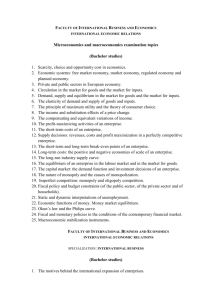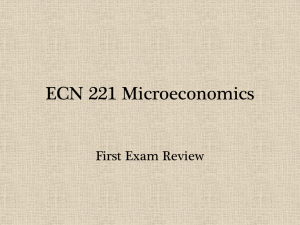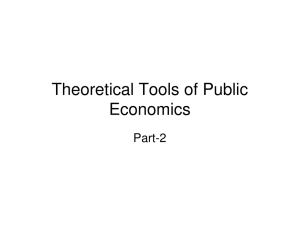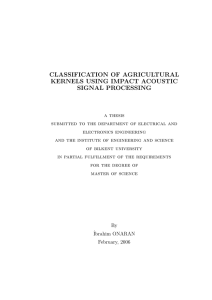Lecture 2: Chapter 1, First Principles
advertisement
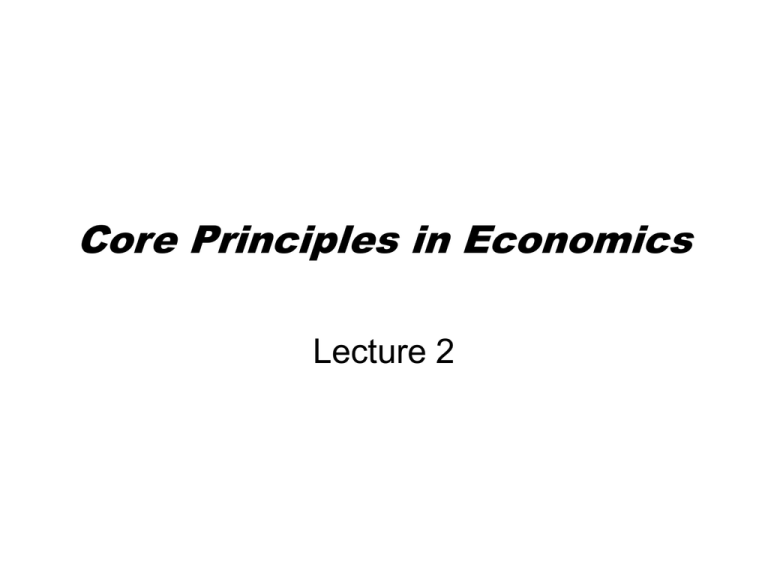
Core Principles in Economics Lecture 2 In This Lecture Chapter 1 introduces you to nine principles or ideas that will reappear throughout this course • Four principles for understanding how individuals make choices • Five principles for understanding how individuals interact (how markets work) How Do Individuals Choose? Four Principles 1) Resources are Scarce • If there was no scarcity in life, would individuals ever have to make a choice between alternative goods or activities? • While income is often thought to limit ones choices, time is the most limiting factor individuals face. • History is replete with examples of attempts to overcome scarcity or limitations. 2) The real cost of a good or activity is what you have to give up to get it • To choose means you have not done some alternative activity -the value of what you have not done is the OPPORTUNITY COST of the activity you have done. • Your out of pocket expenditures will often understate the cost of an activity • ‘No Free Lunch’ -- there is nothing free in life, everything has an opportunity cost Opportunity Cost If the price of a pizza is $10 and a movie is $5, what is the opportunity cost of a pizza in terms of movies? Answer: What is the opportunity cost of a movie in terms of pizza? Answer: Opportunity Cost The Cost of a Life (See handout) What is the opportunity cost in life years of implementing a national 55 mph speed limit instead of mandating that motorcyclists wear helmets? A) B) C) D) 87,000 life years 44.5 life years 0.02 life years 445 life years 4) Individuals seek their self interest • Most fundamental assumption in economics -- the weighting of the benefits and costs of alternative decisions • Doesn’t mean that all individuals have the same self interest or desires (they will not necessarily make the same choices if confronted with the same set of choices) • Consumer Sovereignty -- individuals know what is in their best interest • Individuals reveal their self interests through their choices -Theory of Revealed Preferences Individuals make different type of economic decisions • “Whether to” decisions – To enter the labor market – To buy a car • “How much” decisions – How many hours to work – How much to pay for transportation services 3) Decisions are made on the margin • Many decisions are not all or nothing decisions but more of ‘how much’ type of decisions • This principle is more about process of making decisions -- individuals continually ask themselves can they improve upon what they are doing -- than the nature of the decision • If individuals have only ‘local’ information can they still find what is in their best interest? Thinking on the Margin • At x*, y = f(x) is maximized y • The slope of f(x) is equal to f’(x)=y/x f’(x)>0 if x<x* f’(x)=0 if x=x* f’(x)<0 if x>x* y=f(x) x x* Goal is find x where f’(x)=0 f’ Father of Marginal Analysis Alfred Marshall (1842-1924) Brought mathematics into the study of economics but never wanted the mathematics to overshadowed the economics. Consequently, his books were aimed toward the layman. Taught Pigou and Keynes A Comment on Economic Time • The exact time period that we will analyze is fixed but its length (day, month, year) is rarely specified. • Micro analysis is concerned with ‘flows’ not ‘stocks’. For example, how much of income will I spend on housing services this year? • When this time period is over, the next will begin. The question the individual faces is how much will they want undertake in each time period, assuming that the conditions they face remain the same. How Do Individuals Interact? Five Principles 5) There are gains from trade • This principle will be the focus of next lecture. • Voluntary trades will be beneficial to both parties, otherwise why would they have traded? • Everyone will have a comparative advantage in some activity and consequently there will be gains to specializing in that activity and using surplus production to trade for other goods or services. 6) Markets move toward equilibrium • Markets -- interaction between individuals • free markets are where there is no coercion to trade or interact • Coordination of the interaction of individuals is achieved through prices (trading rates). • Equilibrium -- where no individual has an reason to change their action • If individuals are free to trade then trading will continue until no one else wishes further trades 7) Resources should be used efficiently to achieve society’s goals • Efficiency -- the inability to improve one person’s well being without hurting someone else (Pareto Optimality) • If we are inefficient in our use of resources, we are wasting them. • Why would you want to deny someone additional welfare if it didn’t hurt anyone else’s welfare? • This is a normative statement. What about other goals for society such as fairness or equity in the distribution of society’s wealth? 8) Market usually lead to efficiency • This statement is often taken to mean that society (a collective decision perhaps taken by government) should not interfere with individual choice. A positive statement leading to a normative conclusion. • But markets can fail to achieve an efficient result-- for example, congestion on the highways. 9) When markets are not efficient, government intervention can lead to improvement in social welfare • Yet there isn’t a guarantee that governments will improve upon the market outcome. Rather they hold out the possibility to improve upon the efficiency of the outcomes of individual choice. • Important to remember -- it is not that individuals make ‘bad’ choices it is that market has failed to coordinate their decisions Summary: Nine Principles 1) Resources are scarce 2) Every Choice has an Opportunity Cost 3) Choices are made at the margin 4) Individuals seek their self interest 5) There are gains from trade 6) Markets move toward equilibrium 7) Resources should be used efficiently 8) Markets usually lead to efficiency 9) When markets don’t achieve efficiency, government intervention can improve social welfare Will we exhaust the world supply of oil? Argument by Analogy: Imagine this room filled with pistachio nuts (with their shells on). I tell you could eat as many of the nuts as you wished and you could invite as many friends into the room as you wished who could also eat the pistachio nuts with the only restriction that you could not take the shells out of the room. There is no time limit or limit on the number of friends that you can invite. Would all of the nuts be eaten? Checking Out • Supermarket Model -- gather all of your purchases into your cart and selecting which line (in front of store) to pay for purchases • Department Store Model -- pay for purchases in the ‘department’ where the goods are located • Airport/Bank/Post Office Model -- Enter a single line and when at head of line go to first available clerk Why do certain stores adopt one method and not the other? Assignment for Next Lecture • Do Homework 1 on ‘Homework Assignment’ -- this homework will cover material on today’s lecture (odd numbered problems from end of Chapter 1) • Read Chapter 2 and Appendix • Topics Next Time – Economic modeling of trade-offs and the benefits to trade








